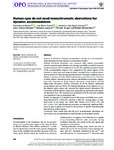Human eyes do not need monochromatic aberrations for dynamic accommodation
| dc.contributor.author | Bernal-Molina, Paula | |
| dc.contributor.author | Marín-Franch, Iván | |
| dc.contributor.author | Del Águila‐Carrasco, AJ | |
| dc.contributor.author | Esteve‐Taboada, JJ | |
| dc.contributor.author | López‐Gil, N | |
| dc.contributor.author | Kruger, PB | |
| dc.contributor.author | Montés‐Micó, R | |
| dc.date.accessioned | 2018-09-20T17:37:37Z | |
| dc.date.available | 2018-09-20T17:37:37Z | |
| dc.date.issued | 2017-09 | |
| dc.identifier.issn | 0275-5408 | |
| dc.identifier.issn | 1475-1313 | |
| dc.identifier.uri | http://hdl.handle.net/10026.1/12389 | |
| dc.description.abstract |
<jats:title>Abstract</jats:title><jats:sec><jats:title>Purpose</jats:title><jats:p>To determine if human accommodation uses the eye's own monochromatic aberrations to track dynamic accommodative stimuli.</jats:p></jats:sec><jats:sec><jats:title>Methods</jats:title><jats:p>Wavefront aberrations were measured while subjects monocularly viewed a monochromatic Maltese cross moving sinusoidally around 2D of accommodative demand with 1D amplitude at 0.2 Hz. The amplitude and phase (delay) of the accommodation response were compared to the actual vergence of the stimulus to obtain gain and temporal phase, calculated from wavefront aberrations recorded over time during experimental trials. The tested conditions were as follows: Correction of all the subject's aberrations except defocus (C); Correction of all the subject's aberrations except defocus and habitual second‐order astigmatism (AS); Correction of all the subject's aberrations except defocus and odd higher‐order aberrations (<jats:styled-content style="fixed-case">HOA</jats:styled-content>s); Correction of all the subject's aberrations except defocus and even <jats:styled-content style="fixed-case">HOA</jats:styled-content>s (E); Natural aberrations of the subject's eye, i.e., the adaptive‐optics system only corrected the optical system's aberrations (N); Correction of all the subject's aberrations except defocus and fourth‐order spherical aberration (SA). The correction was performed at 20 Hz and each condition was repeated six times in randomised order.</jats:p></jats:sec><jats:sec><jats:title>Results</jats:title><jats:p>Average gain (±2 standard errors of the mean) varied little across conditions; between 0.55 ± 0.06 (SA), and 0.62 ± 0.06 (AS). Average phase (±2 standard errors of the mean) also varied little; between 0.41 ± 0.02 s (E), and 0.47 ± 0.02 s (O). After Bonferroni correction, no statistically significant differences in gain or phase were found in the presence of specific monochromatic aberrations or in their absence.</jats:p></jats:sec><jats:sec><jats:title>Conclusions</jats:title><jats:p>These results show that the eye's monochromatic aberrations are not necessary for accommodation to track dynamic accommodative stimuli.</jats:p></jats:sec> | |
| dc.format.extent | 602-609 | |
| dc.format.medium | Print-Electronic | |
| dc.language | en | |
| dc.language.iso | eng | |
| dc.publisher | Wiley | |
| dc.subject | defocus | |
| dc.subject | directional cues | |
| dc.subject | dynamic accommodation | |
| dc.subject | monochromatic aberrations | |
| dc.title | Human eyes do not need monochromatic aberrations for dynamic accommodation | |
| dc.type | journal-article | |
| dc.type | Journal Article | |
| dc.type | Research Support, Non-U.S. Gov't | |
| plymouth.author-url | https://www.webofscience.com/api/gateway?GWVersion=2&SrcApp=PARTNER_APP&SrcAuth=LinksAMR&KeyUT=WOS:000408313900007&DestLinkType=FullRecord&DestApp=ALL_WOS&UsrCustomerID=11bb513d99f797142bcfeffcc58ea008 | |
| plymouth.issue | 5 | |
| plymouth.volume | 37 | |
| plymouth.publication-status | Published | |
| plymouth.journal | Ophthalmic and Physiological Optics | |
| dc.identifier.doi | 10.1111/opo.12398 | |
| plymouth.organisational-group | /Plymouth | |
| plymouth.organisational-group | /Plymouth/Faculty of Health | |
| plymouth.organisational-group | /Plymouth/Faculty of Health/School of Health Professions | |
| plymouth.organisational-group | /Plymouth/REF 2021 Researchers by UoA | |
| plymouth.organisational-group | /Plymouth/REF 2021 Researchers by UoA/UoA03 Allied Health Professions, Dentistry, Nursing and Pharmacy | |
| plymouth.organisational-group | /Plymouth/Users by role | |
| plymouth.organisational-group | /Plymouth/Users by role/Academics | |
| dc.publisher.place | England | |
| dcterms.dateAccepted | 2017-05-26 | |
| dc.identifier.eissn | 1475-1313 | |
| dc.rights.embargoperiod | Not known | |
| rioxxterms.versionofrecord | 10.1111/opo.12398 | |
| rioxxterms.licenseref.uri | http://www.rioxx.net/licenses/all-rights-reserved | |
| rioxxterms.licenseref.startdate | 2017-09 | |
| rioxxterms.type | Journal Article/Review |


